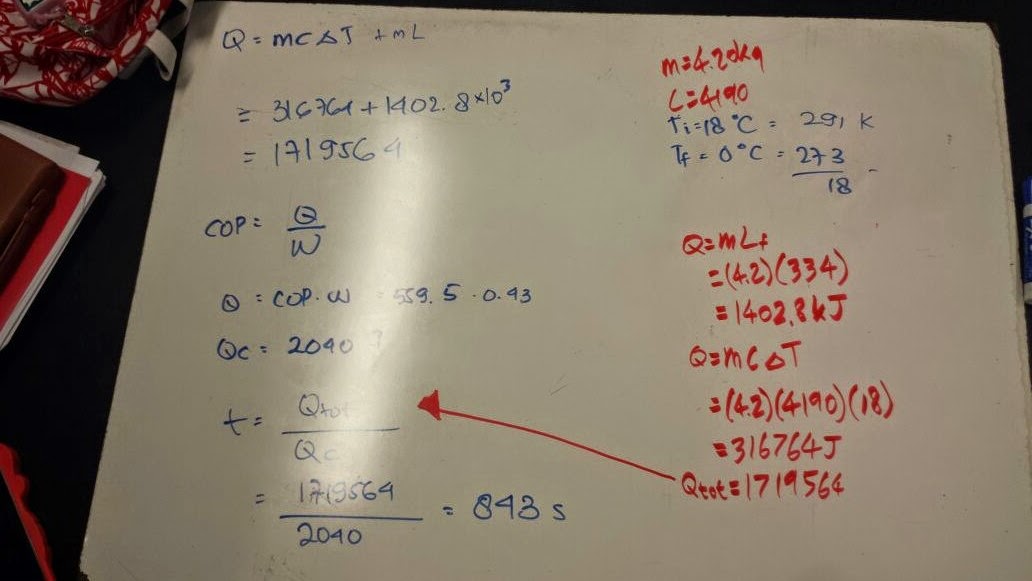Professor Mason
March 17 Class
Diesel Cycle & Entropy and Enthalpy
In class, we learned about diesel cycle and entropy. We started from diesel cycle first; we compared diesel cycle with motor cycle. In diesel cycle, the pressure keeps going, and it keeps compressing until the gas ignite, which means that the pressure is constant; while motor cycle's compression stops at a certain point which makes motor cycle less efficient, and the maximum power is lower.
We also learned about Entropy and Enthalpy in class, which each of them has its own equation. Entropy's equation is defined as [delta S = Q/T], which means that if we derived Q, it becomes [ds = dQ/T]. In class, we learned that Adiabatic process has its Q equals to 0, and it is also called Isoenthropic, which leads to delta S equals to 0 if Q is equal to 0. If entropy's equation has a constant P, the formula becomes [delta S = mC ln(Tf/To)]. The other part that we learned was Enthalpy, which has an equation of [delta H = U + PV], which U is equal to internal energy. In Enthalpy, we also learned that Cp is equal to [dH/dT]. Another form of Enthalpy's equation is [ Q = delta H = Int from T1 to T2 of mCp T dT].
Law of Thermodynamics
We had a review in class about Law of Thermodynamics. The first one defines that energy can't be created or destroyed; the second one states that energy can be created, but not with spontaneously destroyed, while showing the graph above. We also learned about Stirling engine and Brayton cycle, and we did some calculations based on the data we had.
Visible Stirling Engine
 In class, Professor Mason showed us a visible Stirling engine, but with much smaller version. He states that this engine generate electricity from temperature difference. This is how it works: we put ice cube on top of the engine, and the bottom one with hot water, then it will spin like the picture attached below.
In class, Professor Mason showed us a visible Stirling engine, but with much smaller version. He states that this engine generate electricity from temperature difference. This is how it works: we put ice cube on top of the engine, and the bottom one with hot water, then it will spin like the picture attached below.After we put the ice cube on top and the hot water on the bottom, we removed the hot water, so it would be room temperature on the bottom and ice cube on the top, and it was still running. The steps of how this engine works are expansion, transfer, heat transfer contraction, transfer, and repeat. This engine has a double efficiency of solar panel by 23 percent. In class, Professor Mason also showed us a low temperature differential Stirling engine, which has those same steps as the smaller version. This is how the engine's strokes look like.
Two Stroke Engine and Wenkel Engine
As for Wenkel engine, it is different from Two Stroke engine and Stirling Engine. The power rate ratio is bigger because it has more power stroke. The hard part of this engine is the direction of where the forces are going. The strokes are: Intake, Compression, Power, and Exhaust. This is what it looks like.
Calculations
In class, we did some calculations based on the data in the lab book involving those pictures shown above.


 In class we learned that effectiveness is defined as a symbol c, while c is equal to the actual output of energy defined divided by max output of energy by reversible process. This leads to a formula, which happens to be [mc ln(Tf^2/Ta Tb) = mc ln (Tf/Ta) + 0 + mc ln (Tf/Tb)]; that concludes that [Tf^2 = Ta Tb]. There is also an equation that we learned in class, which was [delta s = mL/Tp], [Qc/W = Tc/Th-Tc], [Qc/Tc = Qh/Th], [W = Th Qc/ Tc - Qc], and [delta t = W/P], which [Qh = W + Qc] and [Qc = COP W].
In class we learned that effectiveness is defined as a symbol c, while c is equal to the actual output of energy defined divided by max output of energy by reversible process. This leads to a formula, which happens to be [mc ln(Tf^2/Ta Tb) = mc ln (Tf/Ta) + 0 + mc ln (Tf/Tb)]; that concludes that [Tf^2 = Ta Tb]. There is also an equation that we learned in class, which was [delta s = mL/Tp], [Qc/W = Tc/Th-Tc], [Qc/Tc = Qh/Th], [W = Th Qc/ Tc - Qc], and [delta t = W/P], which [Qh = W + Qc] and [Qc = COP W].In class, professor also showed us an experiment involving bubbles coming from water and soap. Next, professor made another experiment with the bubbles; after the bubbles go up, he set it on fire, and what happened was it ignited and created a flame.






No comments:
Post a Comment